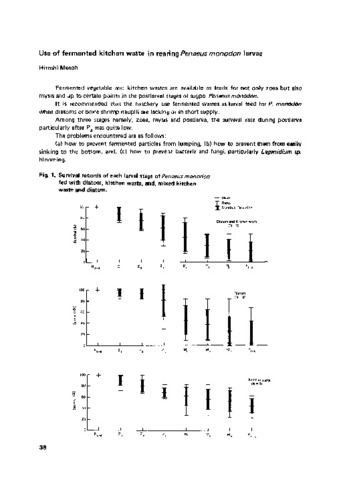Use of fermented kitchen waste in rearing Penaeus monodon larvae
- Global styles
- MLA
- Vancouver
- Elsevier - Harvard
- APA
- Help
Share
Abstract
Fermented vegetable and kitchen wastes are available as feeds for not only zoea but also mysis and up to certain points in the postlarval stages of sugpo, Penaeus monodon. It is recommended that the hatchery use fermented wastes as larval feed for P. monodon when diatoms or brine shrimp nauplii are lacking or in short supply. Among three stages namely, zoea, mysis and postlarva, the survival rate during postlarva particularly after P4 was quite low. The problems encountered are as follows: (a) how to prevent fermented particles from lumping, (b) how to prevent them from easily sinking to the bottom, and, (c) how to prevent bacteria and fungi, particularly Lagenidium sp blooming.
Description
Extended abstract only.
Suggested Citation
Motoh, H. (1977). Use of fermented kitchen waste in rearing Penaeus monodon larvae. SEAFDEC Aquaculture Department Quarterly Research Report , 1(2), 38-40. http://hdl.handle.net/10862/2300
Type
ArticleKoleksi
Related items
Showing items related by title, author, creator and subject.
-
An overview of the nutrition, feed and feeding techniques of prawn penaeid/shrimps
Piedad-Pascual, Felicitas (Philippine Council for Aquatic and Marine Research and Development, 1989)This paper echoes what transpired during the first International Conference of Penaeid Prawns/Shrimps held in Iloilo City in December 4-7, 1984, particularly on the Nutrition nd Feed Development. Around 25 papers were ... -
Series: Aquaculture extension manual; No. 19
Prawn hatchery operations
Parado-Estepa, Fe D.; Quinitio, Emilia T. ; Borlongan, Emeterio L. (Aquaculture Department, Southeast Asian Fisheries Development Center, 1996-05)
The manual, an updated version of the 1984 SEAFDEC/AQD manual, presents the underlying principles and step-by-step instructions of prawn larval and post-larval rearing. The techniques described are not only applicable to ...
; Borlongan, Emeterio L. (Aquaculture Department, Southeast Asian Fisheries Development Center, 1996-05)
The manual, an updated version of the 1984 SEAFDEC/AQD manual, presents the underlying principles and step-by-step instructions of prawn larval and post-larval rearing. The techniques described are not only applicable to ... -
The lowdown on world shrimp culture - II
Yap, Wilfredo G. (INFOFISH, 2001)This paper introduces some new members of the international shrimp culture club and goes on to discuss some recent technological innovations in the industry, particularly the polyculture of tilapia (mainly Oreochromis ...







